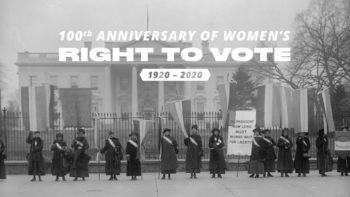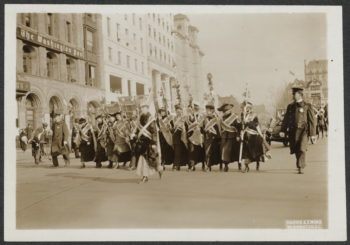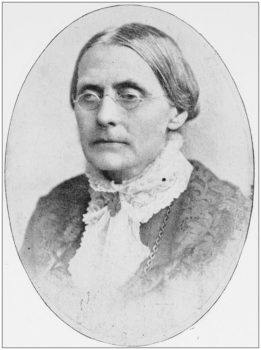What Modern Social Justice Activists Can Learn From The Women’s Suffrage Movement

It took decades of marches, civil disobedience, publications, lectures and lobbying for American women to win the right to vote, and two Texas A&M University professors say modern social justice movements can model suffrage strategies in continuing fights for equality today.
After its first introduction to Congress in 1878, the 19th Amendment to the U.S. Constitution was finally ratified on Aug. 18, 1920.
Today’s activists can learn from the suffrage movement by focusing on single goals, but should vary their strategies and not align with a certain political party, while being patient and persistent, said Elizabeth Cobbs, a professor of American history in the Texas A&M College of Liberal Arts.
Cobbs, who studies the historical rights and roles of women in American society, points to Carrie Chapman Catt, a key figure in the women’s suffrage movement, who wrote in 1926 in Woman Suffrage and Politics, that to get the word male out of the Constitution it “cost the women of this country 52 years of pauseless campaign.”
During that time, activists conducted 56 campaigns of referenda to male voters, 480 campaigns to get legislators to submit suffrage amendments to voters, 47 campaigns to get state constitutional conventions to write woman suffrage into state constitutions, 277 campaigns to get state party conventions to include woman suffrage planks, 30 campaigns to get presidential party conventions to adopt woman suffrage planks in party platforms and 19 successive campaigns with 19 successive Congresses.

Cobbs said the earliest efforts to win the vote can be traced back to nation’s founding when the Declaration of Independence famously stated that “all men are created equal” – itself an untruth as Black men were enslaved in America. Only one of the 13 colonies – New Jersey – in 1776 gave the right to vote to single women who owned property, but in 1807 rescinded that right.
“Racism and sexism both delayed the vote for women,” Cobbs said. “Black and white women were excluded from the expansion of the franchise that came with the 15th Amendment* [giving African-American men the right to vote]. At the time, in 1870, the idea of allowing females to vote was considered too controversial to promote, and reformers prioritized giving the vote to men of color.”
Gender inequity in voting rights can be at least partially attributed to religion, said Valerie Hudson, a university distinguished professor of international affairs at the Bush School of Government & Public Service.
“In Anglo-Saxon law, derived from Judeo-Christian religious doctrine, the concept of ‘coverture’ was adopted,” Hudson said. “The Book of Genesis asserted that the first woman was formed from the rib of the first man. Thus, she was actually ‘part’ of him, and when reunited with her other half in marriage, returned to being ‘part’ of him. So the idea of giving women the right to vote was seen as nonsensical, because he represented her in all things. She was a part of him in a way that he was not part of her.”
Hudson, who studies women’s policy issues in the U.S. and around the globe, has long argued that the first political order in any nation is between men and women. Societies that are highly subordinative of women end up with far worse governments, demographics, economic performance, environmental preservation and health outcomes, she said.
Looking at voting rights across the globe, Hudson said it can finally be said that wherever there is voting, women have the right to vote, but in some places, barriers are purposely placed to discourage it. “Even Saudi Arabia gave women the vote a few years ago,” she said. “But there are many places where women are actively discouraged from going to the polls. A prime example is Afghanistan, where women have even been killed for daring to vote.”

During the suffrage movement in the U.S., activists were often verbally abused, jailed and sometimes physically abused. Probably the most well-known suffragist, Susan B. Anthony, was arrested for voting in the 1872 presidential election. As she boarded the streetcar taking her to jail, she said, “I am traveling at the expense of the government. Ask him for my fare.” After being tried and found guilty of voting illegally, the judge fined Anthony $100, of which she vowed never to pay a penny, and she never did.
“She devoted her life to democracy,” Cobbs said of Anthony, adding that she died in 1906 without ever seeing her dream come true. Later activists Catt and Alice Paul* finished the campaign when Anthony retired. Additionally, Cobbs said, Mary Church Terrell, founder of the National Association of Colored Women and a friend of Anthony, was one of the most passionate and effective lecturers on the right of Black women to vote.
The fact that the women’s suffrage movement was not tied to any particular political party and kept its focus on the right to vote was of great advantage, Cobbs said.
“The movement worked hard to avoid identification with either major political party in order to attract support from both,” she said. “They limited the issue to the vote to avoid getting drawn into arguments over more controversial side issues like the right to divorce – then considered scandalous.”
Since winning the vote, women have slowly outpaced men in voter turnout. According* to the Center for American Women and Politics, in every presidential election since 1980, the proportion of eligible female adults who voted has exceeded the proportion of eligible male adults who voted. The number of female voters has exceeded the number of male voters in every presidential election since 1964. In the 2016 presidential election, 72.8 million women voted compared to 63 million men.
Regardless of women’s increasing participation in voting, men still outnumber women in elected* and leadership positions, and the gender gap in wages continues. According to the U.S. Census Bureau, in 2018 the average full-time woman worker made 82 percent of what a full-time working man made.
“Women carry most of the weight of homemaking and childrearing,” Cobbs said. “As long as this burden – and joy – are unevenly shared, women will have a harder time than men in advancing both politically and economically. Countries that do more to help working women have seen far greater political participation by women than we have. Right now, the United States ranks 53rd in gender equality worldwide.”
While there is still much to be done, both professors agree that in all great fights, progress must be celebrated, and the women’s suffrage movement still stands today as one of the nation’s greatest victories for equality.
“I hope women today feel great gratitude in their hearts for the women, and their male allies, who finally allowed women the vote 100 years ago,” Hudson said. “It remains one of the most remarkable and praiseworthy achievements of our country.”
* This link is no longer active and has been removed.
Media contact: Lesley Henton, lshenton@tamu.edu





